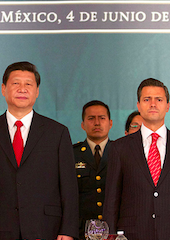Time for a U.S. Pivot to Latin America
Why is China looking more attractive to Latin American countries than the United States?
June 18, 2013

The Obama Administration and U.S. media have made much ado about the U.S. “pivot” to Asia.
What has largely escaped their attention, however, is that China has been lining up economic allies in the erstwhile “backyard” of the United States.
Well, just as serious competition ought to awaken one’s creative juices in business, it is time for the United States to step up a suitable economic policy for Latin America before it is too late.
The difference in approaches by the United States and China in Latin America were squarely brought into focus just in recent weeks when U.S. Vice President Joseph Biden and Chinese President Xi Jinping made tours of Latin America.
The United States principal offer to its Latin American neighbors is the Trans-Pacific Partnership. The TPP offers access to the U.S. market to Latin American and Asian nations on the basis of a triple form of conditionality.
First, they must deregulate their financial markets; second, adopt intellectual property provisions that give preferences to U.S. firms; and third, allow private U.S. firms to directly sue governments of countries that sign up to the TPP for violating any of its conditions.
Talk about a heavily conditioned offering. So what’s the Chinese approach?
On his visit to the region, China’s President Xi Jinping offered more than $5.3 billion in financing, with few conditions attached, to China’s newfound Latin American friends.
These offers will need to be confirmed, but according to press reports the Chinese have signed deals on this trip for:
- $3 billion in commitments to eight Caribbean countries for infrastructure and energy;
- $1.3 billion to Costa Rica in loans and lines of credit, including a $900 million dollar loan from the Chinese Development Bank for upgrading a petroleum refinery and a $400 million dollar line of credit for road infrastructure from the Chinese Ex-Im Bank; and a
- $1 billion credit line from the China Ex-Im bank to Mexico for its state-owned oil company PEMEX.
Making available this financing comes on top of the already $86 billion in financing provided by China to Latin American governments since 2003.
Granted, that amount — large as it sounds — seems just like another number in today’s world.
To put it into proper perspective, consider this:
Since 2003, thus over the past decade, China’s policy banks have provided more finance to Latin America than their counterparts at the World Bank, the Inter-American Development Bank and the U.S. Export-Import Bank.
If anything ought to awaken the United States from its past slumber and taking Latin America essentially for granted, that comparison ought to do it.
Simply put, the United States and the array of largely Western-dominated international financial institutions have been outgunned by China’s financial muscle. Welcome to the brave new world!
But it’s not just a matter of sheer numbers. Unlike U.S. trade treaties or the finance from the international financial institutions largely under U.S. control, China offers up its loans come with few strings attached.
In a region that is understandably very sensitive to any notions of conditionality due to painful past experiences with the IMF and the World Bank, China makes sure that its policy is not based on conditionalities.
That said, the Chinese don’t lack a strong commercial focus. Often times the Chinese provide a tied offer — requiring that Chinese firms will be hired to conduct a bulk of the envisioned project work.
What is more, the U.S. offer of a Trans-Pacific Partnership to all of the Latin American countries in the TPP process doesn’t amount to much in the real world.
They already have trade treaties with the United States that grant them access to the U.S. market.
In just a few years, China has become the number one (in the case of Brazil and Chile) or number two trading partner (for Peru and Mexico).
These aren’t just any countries. They are the most important economies in Latin America.
Of course, the United States is still the most important economic partner for the region overall. However, it cannot continue to take the region for granted.
For too long, the United States has relied on a rather imperial mechanism — just telling Latin America what it needs. Compare that to China’s approach: It offers Latin America what it wants (in the form of financing and trade from China).
When President Obama took office, he and his team pledged to hit the reset button with the region and rethink its trade regime with Latin America. It hasn’t worked out that way.
Thus far, “reset” has essentially meant making the same old offer, but via new faces.
In addition, too much of the interaction with regional governments has been on such efforts as concentrating on drug interdiction purposes.
Those countries rightfully don’t see that as much of a growth-enhancing development approach, but rather as a foreign-based, defensive mechanism to protect the U.S. homeland.
Given all that, it is high time for the U.S. government to undertake a true rethink of its economic policy toward Latin America. Very soon, it may be too late.
Read previous

Syria, Iran and American Forgetfulness
June 17, 2013
